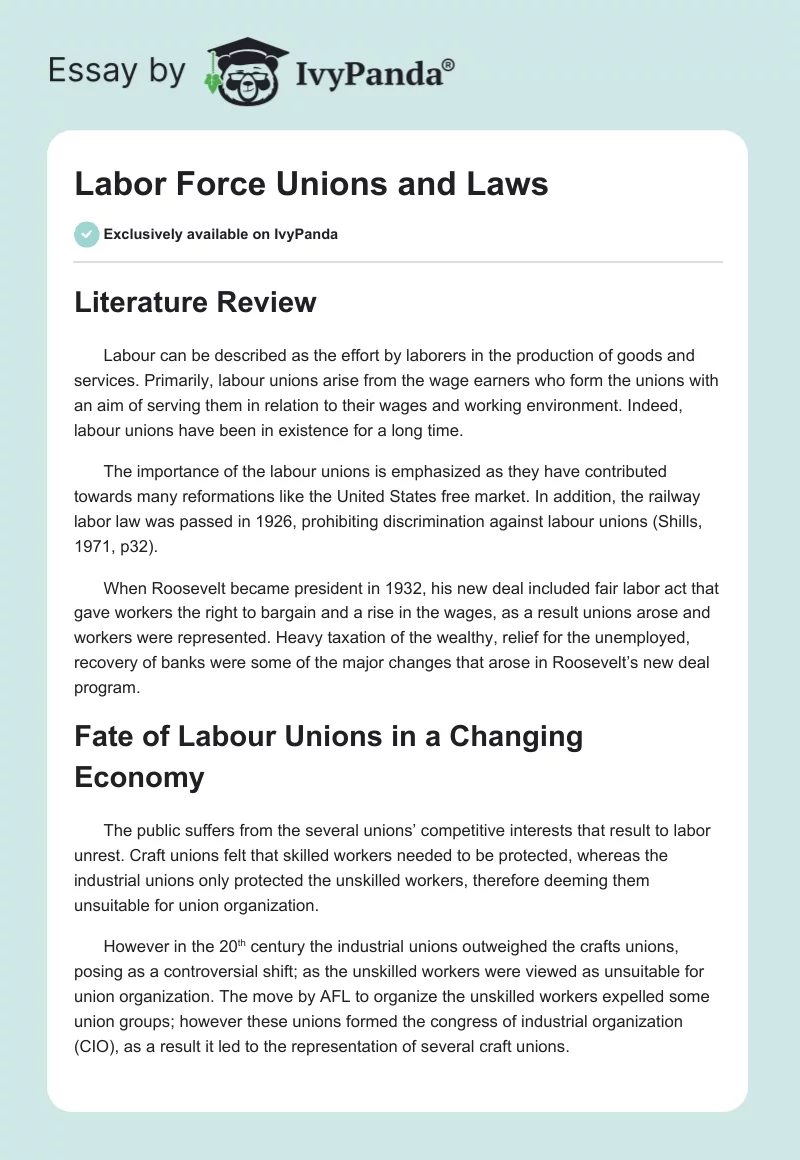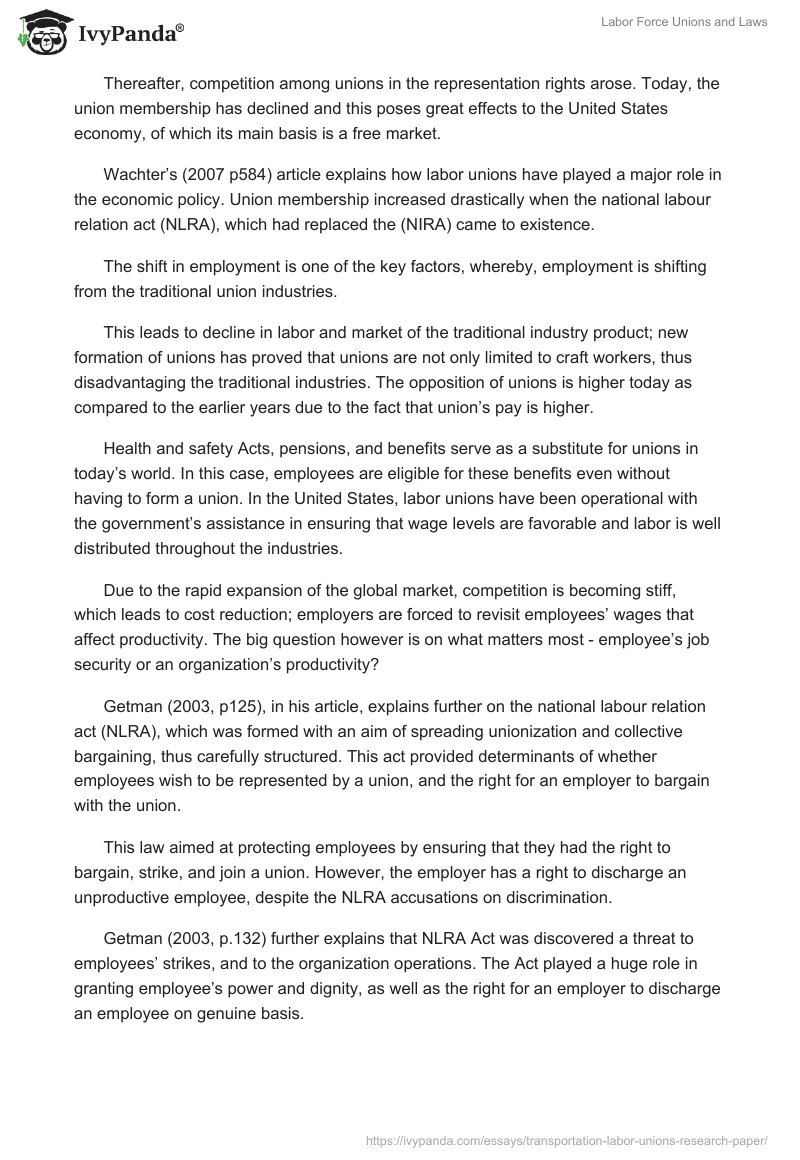Literature Review
Labour can be described as the effort by laborers in the production of goods and services. Primarily, labour unions arise from the wage earners who form the unions with an aim of serving them in relation to their wages and working environment. Indeed, labour unions have been in existence for a long time.
The importance of the labour unions is emphasized as they have contributed towards many reformations like the United States free market. In addition, the railway labor law was passed in 1926, prohibiting discrimination against labour unions (Shills, 1971, p32).
When Roosevelt became president in 1932, his new deal included fair labor act that gave workers the right to bargain and a rise in the wages, as a result unions arose and workers were represented. Heavy taxation of the wealthy, relief for the unemployed, recovery of banks were some of the major changes that arose in Roosevelt’s new deal program.
Fate of Labour Unions in a Changing Economy
The public suffers from the several unions’ competitive interests that result to labor unrest. Craft unions felt that skilled workers needed to be protected, whereas the industrial unions only protected the unskilled workers, therefore deeming them unsuitable for union organization.
However in the 20th century the industrial unions outweighed the crafts unions, posing as a controversial shift; as the unskilled workers were viewed as unsuitable for union organization. The move by AFL to organize the unskilled workers expelled some union groups; however these unions formed the congress of industrial organization (CIO), as a result it led to the representation of several craft unions.
Thereafter, competition among unions in the representation rights arose. Today, the union membership has declined and this poses great effects to the United States economy, of which its main basis is a free market.
Wachter’s (2007 p584) article explains how labor unions have played a major role in the economic policy. Union membership increased drastically when the national labour relation act (NLRA), which had replaced the (NIRA) came to existence.
The shift in employment is one of the key factors, whereby, employment is shifting from the traditional union industries.
This leads to decline in labor and market of the traditional industry product; new formation of unions has proved that unions are not only limited to craft workers, thus disadvantaging the traditional industries. The opposition of unions is higher today as compared to the earlier years due to the fact that union’s pay is higher.
Health and safety Acts, pensions, and benefits serve as a substitute for unions in today’s world. In this case, employees are eligible for these benefits even without having to form a union. In the United States, labor unions have been operational with the government’s assistance in ensuring that wage levels are favorable and labor is well distributed throughout the industries.
Due to the rapid expansion of the global market, competition is becoming stiff, which leads to cost reduction; employers are forced to revisit employees’ wages that affect productivity. The big question however is on what matters most – employee’s job security or an organization’s productivity?
Getman (2003, p125), in his article, explains further on the national labour relation act (NLRA), which was formed with an aim of spreading unionization and collective bargaining, thus carefully structured. This act provided determinants of whether employees wish to be represented by a union, and the right for an employer to bargain with the union.
This law aimed at protecting employees by ensuring that they had the right to bargain, strike, and join a union. However, the employer has a right to discharge an unproductive employee, despite the NLRA accusations on discrimination.
Getman (2003, p.132) further explains that NLRA Act was discovered a threat to employees’ strikes, and to the organization operations. The Act played a huge role in granting employee’s power and dignity, as well as the right for an employer to discharge an employee on genuine basis.
Collective bargaining gave the American unions’ political power, resources, and leverage, thus forcing an employer to make reasonable rules that promote productivity. Dispute resolution was therefore successful and fast.
According to Getman (2003), courts surprisingly started viewing NLRA issue on collective bargaining as interference, other than solution. It is however evident that lack of right to strike leads to ineffective collective bargaining, thus the desire to join unions is crashed.
Baird (1987, p.934) further suggested that the whole unionism should be eliminated and pave way for a rather voluntary one, which incorporates less conflict between labor law and labor management co-operation. The author views compulsory bargaining as a threat to the development of labour management, hence appealing for laws that contain no threat.
Baird adds that the Clayton Act (1914), Norris-La Guardia Act (1932), and the NLRA (1934) generally affected the labor market. This is evident as the Clayton Act contributed to the granting of immunity to the labour unions from the trust laws, while the Norris-La Guardia Act outshined the yellow dogs contracts, which existed between the employees and employers.
The Clayton and Norris-La- Guardia law states that, one union could represent majority of workers in an industry, without fear of violating neither the anti-trust laws nor antitrust persecution. In addition, the exemption of labour union from the antitrust laws contributed to the stiff competition between already existing labour unions and the interlopers.
When different unions represented employees from different industries, competition would be evident among the unions. NLRA characteristics involved union representation, union security, and the creation of job property rights for the employees involved in strikes.
Such characteristics hindered the discovery of other forms of labor-management relations, which would have assisted the unionized industries in adapting to the changing market conditions.
The presence of a bargaining agent hinders competition among unions in the same firm or between union and non-unions, since individual employees are incapable of representing themselves.
A certified bargaining agent has a monopoly power granted by the government that allows innovations aimed at benefiting both the employers and the employees (Baird, 1987, p.941). It is however clear that the compulsory bargaining power in the NLRA Act should be disregarded.
According to Hogler R, (2006 p101), in the fifty’s the united states union membership was a third of the non- agricultural workforce, however by 2004 the membership had dropped to 12.5%. However with the presence of NLRA act, workers found a means of equalizing power through collective bargaining, as a means of national uniformity.
The employee representation plans were given attention in 1870’s due to their advantageous factors that included the reduction of labor conflict, (Hogler, 2006 p110). The transit management and transit unions recognized the need of working together in order to achieve a common interest, hence maximizing on collective bargaining.
The amalgamated transit union (ATU) was to fight for the rights of workers. This union led to the formation of urban mass transportation act (UMTA) which preserved the union’s rights, (Oestreich & Whailey, 2001 p8).
Today, both the management and the unions in the transit industry play a vital role in ensuring that the industry remains competitive, through initiating of a collective bargaining agreement. Therefore a clear indication of the importance of unions and management co-operation in relation to employees and the industry welfare.
Conclusion
Due to the continued decline, there is need for a union labor force that is self-perpetuating in our current economic state, the need for a legal and institutional review is important in the determination of whether the current labour laws are supportive of the public welfare needs and remain competitive in a new global economy.
There is an arising need to amend labor laws that act as a threat to labor and management collaboration. Concentration should be based on a new form of labor laws, which will ensure the existence and development on fresh unionism, which does not pose as a threat, but as an advantage to both employees and the employers.
The need for labor laws that are beneficial to employees in term of enhancing their lives is necessary. In addition, any newly formed Labor laws should be able to merge well with the labor management relations.
References
Baird, C. (1987). Cooperation: two incompatible views. Cato Journal, Vol. 6, No. 3. Cato Institute publishers. Web.
Getman, J. (2003). The national labor relations act. What went wrong; can we fix it? Web.
Hogler, R. (2006). The historical misconception of right to work laws in the united states; senator Robert Wagner, legal policy and the decline of American unions. Web.
Oestreich, H. and Whaley, G. (2001). Transit labor relations guide. MTI publishers. Web.
Shills, E. (1971). Union fragmentation: a major cause of transportation labor crises. 25 Indus. & Lab. Rel. Rev. 32 (1971-1972). Web.
Wachter, M (2007). Labor unions: a corporatist institution in a competitive world. Web.


